We bought this shredder a few years ago now and although it’s broken it’s done all right considering we only paid a few pounds for it. It seems at least Amazon still sell this item but I don’t remember paying that much for it. As shredders go it’s not really up to much, it’s a straight cut only to DIN 2 security levels. The box is too small to hold more than a few sheets but that’s not such an issue as you quickly become fed up with turning the handle and feeding (thin) paper in one sheet at a time. As the whole device weighs about as much as a feather you have to hold it with one hand and turn the handle with the other to when shredding which is also irritating. If you aren’t doing much shredding though it’s probably an ok option.
What we tend to do, however, is have a big shred once a year where we get rid of all the old bills and things. What that really calls for is a motorized shredder so… hand powered shredder meet Mr Drill. If you pull the handle off there is a hexagonal bar sticking out which it’s easy to attach a hand-held drill to. Shredding then progresses much more quickly and the device can even do a couple of sheets at a time. What it can’t do, however, is shred old passports. The UK used to issue visitors passports on a medium weight card and we had one hanging around which we wanted to get rid off. It started off fine but around half way though it switched from cutting to just feeding the card through.
Anyway, enough talking lets look inside…
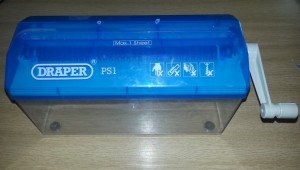 |
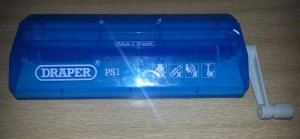 |
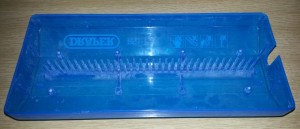 |
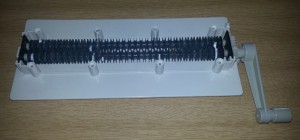 |
| 1 | 2 | 3 | 4 |
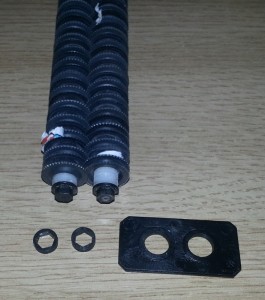 |
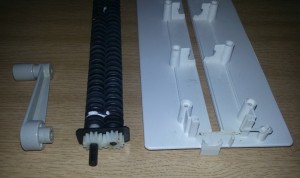 |
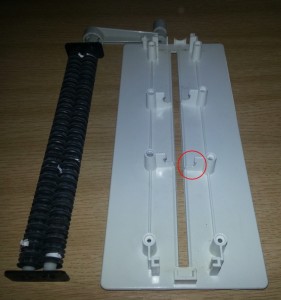 |
|
| 5 | 6 | 7 |
As I mentioned the device (1) is small, probably less than 20cm tall. The top (2) just lifts off the catch box below giving ample opportunity for it to spread shreddings everywhere – the pressure builds up as you try to squeeze more shreddings into the box until the top pops off normally. The underside of the top half has eight of the cheapest and nastiest screws I’ve ever seen holding the mechanism (4) in place. I ended up drilling two of them out hence the damage to the casing. The mechanism itself is really quite simple just two counter rotating cutting wheels. Notice that the casing has fins (3) molded into it which slip between the cutting wheels. I presume this is to stop shreddings getting wrapped around the cutting wheels (they don’t work).
At each end there is a plate which is used to maintain the correct separation of the cutting wheels (5). The plate slips into a molded slot on the base plate. Rather than proper bearings there are just a couple of friction bearings that slip onto the end of hexagonal bar that runs the length of the cutting wheel (and fall of given half a chance).
The driven end of the device (6) just has a couple of plastic gears that slip onto the slightly longer ends of cutting wheels hexagonal shaft. The gears show no sign of wear despite the fact I’ve often hooked this up to a drill and driven it well beyond its stated capacity. Notice that there is a little vertical piece of molding used to hold the driven gear onto the shaft. It’s a reliable if cheap way to hold things in place. This photo (6) also shows the one piece of superfluous equipment. There is a little plastic clicker (right hand side bottom of the base plate) which seems to serve no purpose other than to make a noise as you turn the handle.
Finally we see why the thing failed (8, highlighted). The cutter wheels rely on the base molding to apply pressure to the axle while paper is being fed through. The feeding of a piece of moderately heavy card combined with the fact the wheels were rotating faster than designed has melted the support brackets. Careful examination shows that this has been happening for a while so I’m guessing it would also be a failure point if the machine was operated only by hand.
I’m really temped to try to build a more robust base plate for the cutting mechanism. It would be interesting to see how fast I can get the shredder going and what it can eat when it has some proper support. I think I’d need a welder though to do it quickly so I’ll probably just put the mechanism aside for now.
